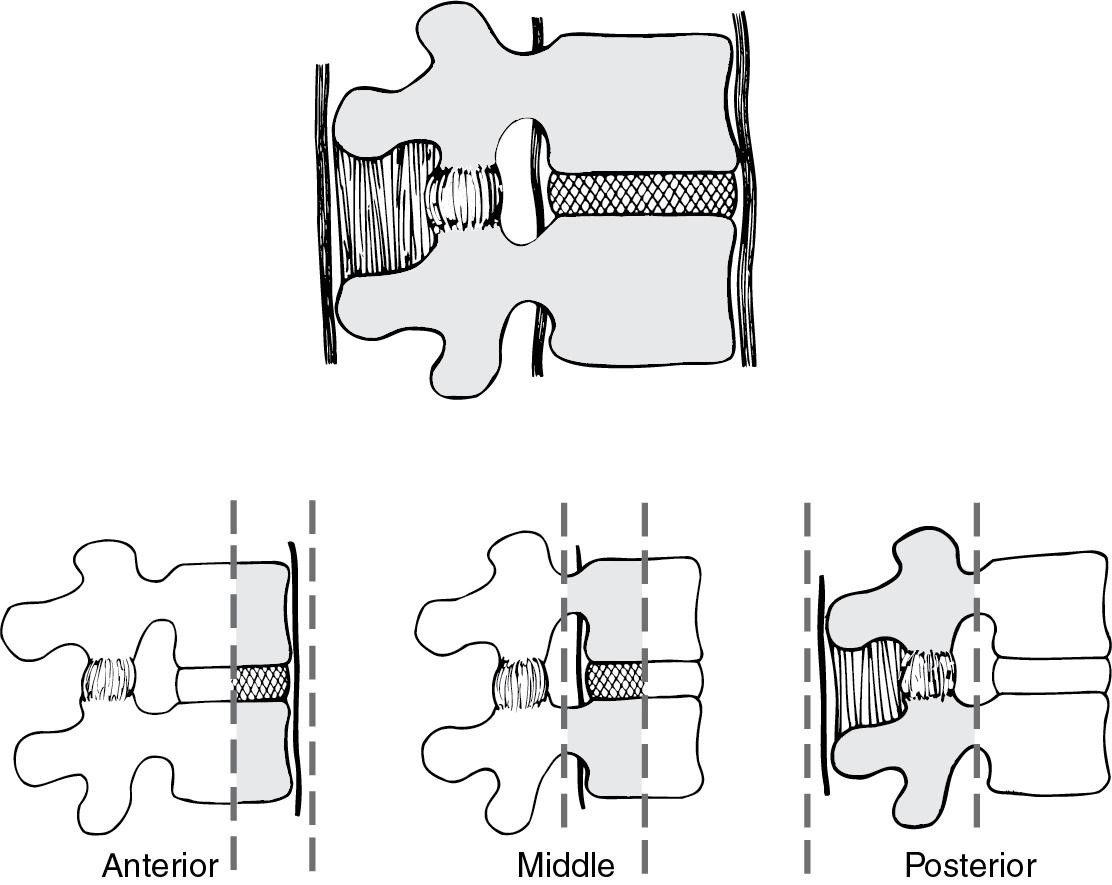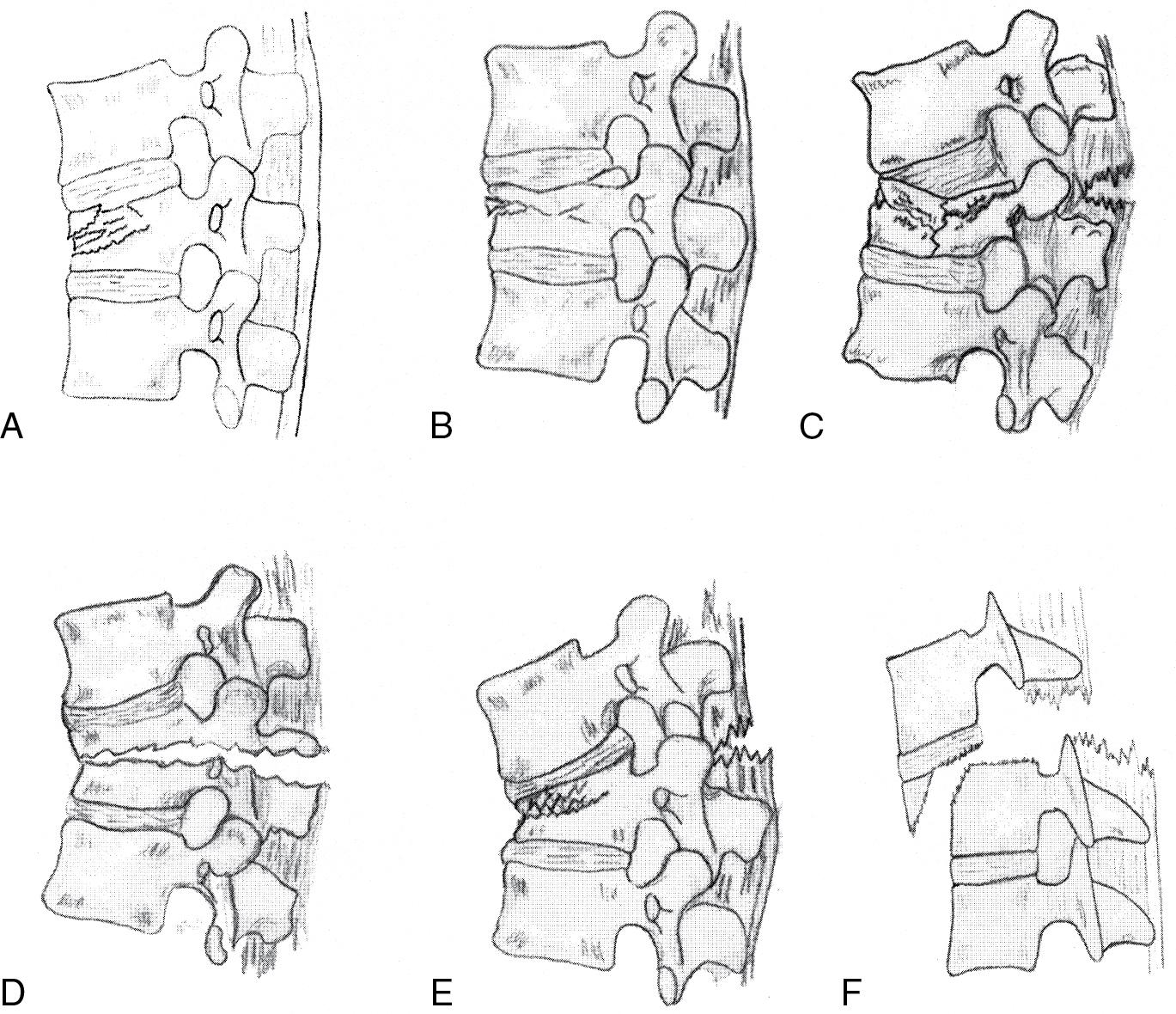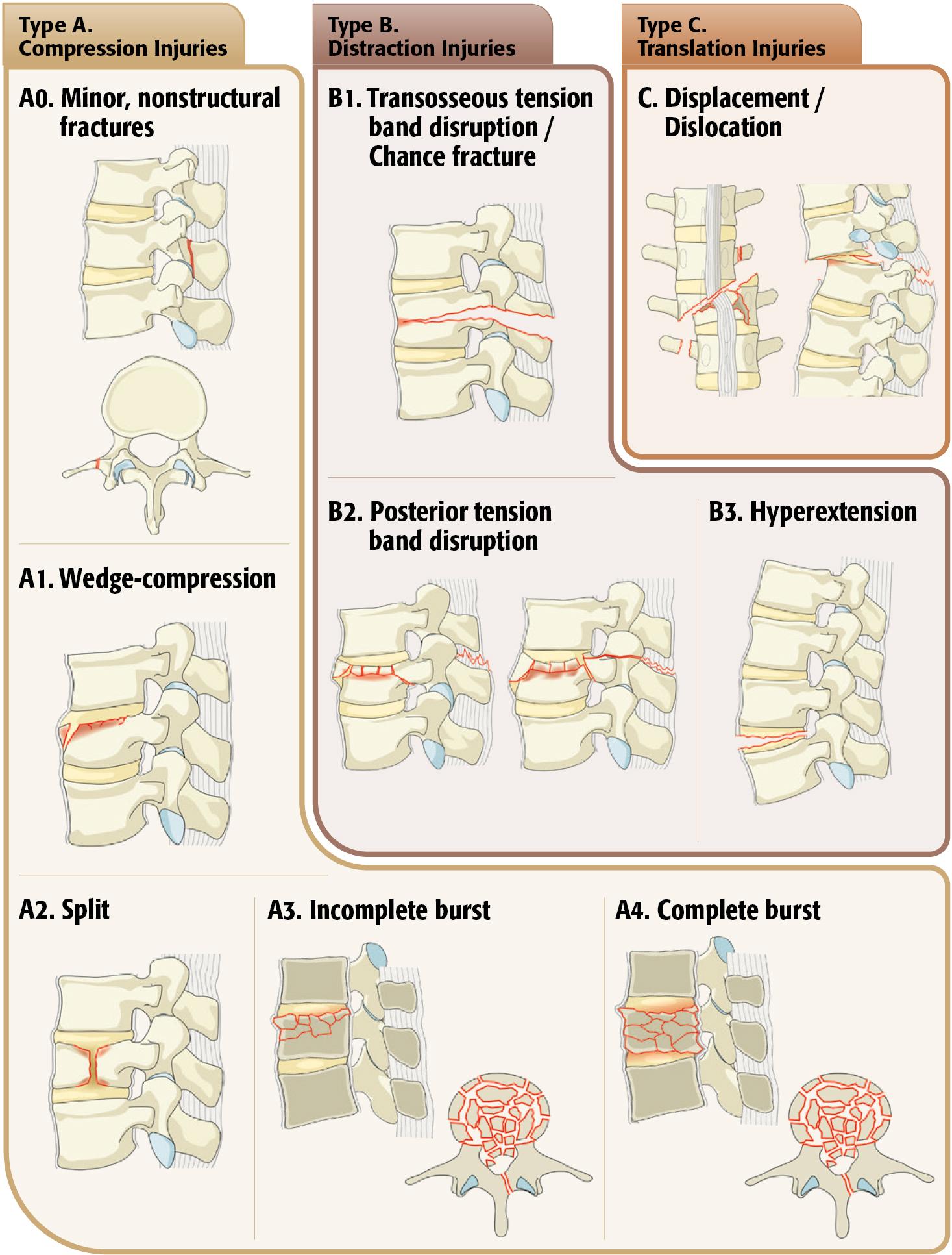Physical Address
304 North Cardinal St.
Dorchester Center, MA 02124
The thoracic and lumbar spinal fractures occur in three distinct anatomic regions: the thoracic (T1–T9), thoracolumbar (T10–L2), and low lumbar (L3–L5) regions.
The thoracic region is aligned in kyphosis, has limited mobility except for rotation due to coronal orientation of the facet joints, and is stabilized by the rib cage, sternum, and thickened ligaments. The spinal canal is narrowest in the thoracic region and occupied by the spinal cord, which is poorly vascularized and susceptible to injury with high-energy injury mechanisms.
The thoracolumbar junction is neutrally aligned in the sagittal plane and serves as a transition area between the stiff thoracic region and the mobile lower lumbar region, which increases susceptibility to injury compared with adjacent regions. Facet joint orientation changes to a more sagittal alignment, which favors flexion-extension motion and limits rotation. The contents of the spinal canal in the thoracolumbar region vary with a transition from spinal cord to conus medullaris and cauda equina at L1–L2. Over 50% of vertebral body injuries and more than 40% of all spinal cord injuries occur in this spinal region. Injuries to the lower part of the spinal cord, the conus medullaris, are often associated with permanent impairment of bowel and bladder function.
The lower lumbar region is highly mobile and possesses a wide range of flexion-extension but limited rotation as a consequence of the sagittal orientation of the facet joints. Sagittal alignment is lordotic and any degree of kyphosis in this region is poorly tolerated. The spinal canal has a larger diameter than in the thoracic or thoracolumbar regions and is occupied by the cauda equina and exiting nerve roots, which are less susceptible to injury and have a better prognosis for recovery compared with injuries to the spinal cord or conus medullaris.
There is a 5%–20% chance that a patient has a second fracture in a different region of the spine. Factors that increase the risk of missed spine fractures on initial evaluation include head injuries, intoxication, drug use, and polytrauma.
Plain radiography plays a lesser role in the initial imaging evaluation of the potentially injured spine patient than in past years and has been largely replaced by multidetector computed tomography (CT). Adequate sagittal and coronal reconstructions of the spine can be obtained from CT scans of the chest, abdomen, and pelvis performed during an initial trauma evaluation and are more sensitive for the detection of osseous spinal injuries compared with radiographs. Plain radiography continues to play a role in monitoring nonoperatively and operatively treated patients and provides the ability to image the spine in the weight-bearing position. Magnetic resonance imaging (MRI) plays a complementary role in the evaluation of spine trauma and is used to assess patients with neurologic deficits and to evaluate specific injury types including ligamentous injuries, traumatic disc herniations, and pathologic fractures. (6)
Various classification systems have evolved over time based on a range of injury parameters, including assessment of spinal stability, presumed mechanism of injury, and fracture morphology. More recent classification systems have incorporated neurologic status and clinical factors considered to play an important role in treatment decision making.
Clinical instability of the spine has been defined as the loss of the spine’s ability to maintain its patterns of displacement under physiologic loads so that no initial or additional neurologic deficit, major deformity, or incapacitating pain occurs. (1) This definition is difficult to apply to clinical practice. Mechanical instability refers to the inability of the injured spine to maintain alignment under physiologic loads due to the onset of significant pain or deformity. The presence of mechanical instability may be inferred from injury morphology on static imaging studies or assessed more directly based on upright radiographs, but remains challenging to precisely define. Neurologic instability is defined by the presence of neurologic findings at the time of postinjury evaluation. Injuries sufficiently severe to cause neurologic injury are usually mechanically unstable. Neurologic status is considered the most important clinical factor influencing treatment of a thoracic or lumbar spine fracture. (2)
A detailed neurologic examination consistent with the International Standards for Neurological Classification of Spinal Cord Injury (ISNCSCI) is performed and includes testing of sensory, motor, and reflex function, as well as a rectal examination. Neurologic status is reported using the American Spinal Injury Association (ASIA) Impairment Scale (AIS) . For fractures that occur at the level of the spinal cord, neurologic status is graded as complete neurologic injury (ASIA A, complete lack of motor and sensory function below the level of injury, including the anal area), incomplete neurologic injury (ASIA B, sensory incomplete; ASIA C, motor incomplete with presence of voluntary anal contraction or half of muscles below the neurologic level of injury rated less than grade 3; ASIA D, at least half of muscles below the neurologic level of injury rated grade 3 or greater), or normal neurologic status (ASIA E). For fractures associated with neurologic injury at the level of the conus medullaris of the spinal cord, neurologic status is graded as complete or incomplete depending on neurologic findings that are present, which may include an areflexic bowel and bladder, lower extremity sensory loss, and incomplete paraplegia. For fractures associated with cauda equina injury, variable lower extremity motor and sensory function, bowel and bladder dysfunction, and saddle anesthesia may be present and require detailed neurologic assessment.
Denis proposed a three-column model of the thoracic and lumbar spine ( Fig. 58.1 ):
The anterior column is composed of the anterior longitudinal ligament, anterior half of the vertebral body, and anterior half of the disc.
The middle column is composed of the posterior half of the vertebral body, the posterior half of the disc, and the posterior longitudinal ligament.
The posterior column includes the pedicles, facet joints, laminae, and posterior ligament complex.

Fractures were classified as minor or major. Minor fractures included fractures of the transverse processes, articular processes, pars interarticularis, or spinous processes. Major fractures were defined based on mechanism of injury and classified into four main fracture types: compression, seat belt, burst, and fracture-dislocations, and further subclassified into more than 16 injury subtypes. The complexity of this classification and the recognition that the middle spinal column was not the primary determinant of spinal instability led to additional research regarding thoracolumbar fracture classification.
The McAfee Classification expanded Denis’s concepts and classified thoracic and lumbar spine fractures into six patterns according to the mechanism and morphology of injury based on CT scan analysis. Six injury patterns were identified based on the forces (compression, axial distraction, or translation) that disrupt the middle spinal column: wedge compression fracture, stable burst fracture, unstable burst fracture, Chance fracture, flexion-distraction injury, and translational injury. These injury pattern descriptors have become widely adopted.
Compression fracture: Isolated failure of the anterior column due to flexion loading. Also referred to as a wedge compression fracture.
Stable burst fracture: Anterior and middle column failure due to compressive loading without loss of integrity of the posterior column.
Unstable burst fracture: Anterior and middle column failure in compression and posterior column disruption due to compression, lateral flexion, or rotation.
Chance fracture: Horizontal fracture around an axis anterior to the anterior longitudinal ligament, which results in tensile failure of the anterior, middle, and posterior columns, and disruption of bone, ligamentous structures and/or the intervertebral disc.
Flexion-distraction injury: An injury due to flexion around an axis located posterior to the anterior longitudinal ligament, which results in compressive failure of the anterior spinal column and tensile failure of the middle and posterior columns.
Translational injury: An injury that results in malalignment of the neural canal due to vertebral displacement in the transverse plane. Injury pattern includes dislocations and fracture-dislocations ( Fig. 58.2 ).

The AO/Magerl classification identifies three major injury patterns according to the primary injury mechanism assessed from radiographs: Type A: compression injuries, type B: distraction injuries, and type C: torsional injuries. Type A fractures are due to anterior column failure in compression and include compression fractures and stable burst fractures. Type B fractures include unstable burst fractures, Chance fractures, flexion-distraction injuries, and extension injuries. Type C fractures consist of translational injuries. A limitation of this original classification was the subdivision of primary injury types into more than 50 distinct injury patterns, which limited its applicability to clinical practice.
The Thoracolumbar Injury Classification and Severity Score (TLICS) was introduced to address limitations of previous spine injury classifications, including failure to consider neurologic injury status, define spinal instability, incorporate MRI data, or provide guidelines for nonoperative versus operative treatment. TLICS provides a composite injury severity score derived from three critical injury components based on assessment of imaging studies (radiographs, CT, and MRI), as well as neurologic status:
injury morphology,
neurologic status, and
integrity of the posterior ligamentous complex (PLC).
The classification system assigns between 1 and 4 points to each critical injury component, which are combined to determine the total composite injury severity score . A score of 3 or less suggests nonoperative treatment; a score of 4 suggests either nonoperative or operative treatment; and a score of 5 or greater suggests operative treatment. Limitations of this classification related to lack of agreement regarding precise definitions of injury morphology and PLC integrity and led to efforts to develop a consensus-based classification ( Table 58.1 ).
| POINTS | |
|---|---|
| Injury Morphology | |
| Compression fracture | 1 |
| Burst fracture | 2 |
| Translational-rotational injury | 3 |
| Distraction injury | 4 |
| Neurologic Status | |
| Intact | 0 |
| Nerve root injury | 2 |
| Incomplete spinal cord or conus injury | 3 |
| Complete spinal cord or conus injury | 2 |
| Cauda equina injury | 3 |
| Posterior Ligamentous Complex Integrity | |
| Intact | 0 |
| Indeterminate | 2 |
| Disrupted | 3 |
The AOSpine Thoracolumbar Spine Injury Classification (3) builds on the classic AO/Magerl spine classification to address limitations of previous injury classifications. Injuries are stratified based on fracture morphology, neurologic status, and case-specific modifiers. The three main injury morphologies are: Type A , compression injuries with an intact tension band; Type B , anterior or posterior tension band injuries that occur through distraction; Type C , injuries associated with translation along any axis. The injury level and type are used to classify the injury. When multiple injury types occur in the same patient, the injury with the highest severity determines the grade. Any additional injuries and any modifiers that are present are identified in parentheses. Multilevel injuries are classified separately and recorded in order of declining severity. Note that type A and B1 injuries affect a single vertebral body level while type B2, B3, and C injures involve at least one motion segment.
Injury types
Type A injury: Compression injury with an intact tension band
A0: Soft tissue injury or minor fracture involving the lamina or transverse process
A1: Compression fracture involving a single endplate without involvement of the posterior vertebral wall
A2: Coronal split or pincer-type fracture involving both endplates without any involvement of the posterior wall of the vertebral body
A3: Incomplete burst fracture involving a single endplate with involvement of the posterior vertebral body wall
A4: Complete burst fracture or sagittal split involving both endplates with involvement of the posterior vertebral wall, but without disruption of the posterior tension band.
Type B injury: Anterior or posterior tension band injury
B1: Monosegmental osseous failure of the posterior tension band extending into the vertebral body (Chance fracture)
B2: Posterior tension band injury affecting capsule/ligamentous structures. It may involve any combination of bony, capsuloligamentous, or ligamentous structures. Associated type A fractures are classified separately.
B3: Anterior tension band injury with disruption or separation of anterior structures (bone or disc) without translation, which is limited by intact posterior elements. Most commonly occurs in an ankylosed spine due to a hyperextension injury.
Type C injury: Injury with translation in any axis.
Neurologic status modifiers
N0: Neurologically normal
N1: Transient neurologic deficit that has resolved
N2: Radiculopathy
N3: Incomplete spinal cord injury or any degree of cauda equine injury
N4: Complete spinal cord injury
NX: Unexaminable patient
N+: Ongoing spinal cord compression
Case-specific modifiers
M1: Indeterminate injury to the posterior tension band based on clinical exam or imaging studies (i.e., MRI)
M2: Patient-specific comorbidities that influence surgical decision making such as metabolic bone diseases (osteoporosis), ankylosing disorders (ankylosing spondylitis [AS], Diffuse Idiopathic Skeletal Hyperostosis [DISH]), or burns or abrasions involving skin across the injured spinal levels ( Fig. 58. 3 ).

Minor nonstructural fractures, vertebral body compression fractures, and burst fractures without disruption of the PLC, which occur in neurologically intact patients, are treated without surgery. Based on AOSpine Thoracolumbar Spine Injury Classification, A0, A1, A2, and A3 injuries are generally treated nonoperatively in neurologically intact patients. Contraindications to orthotic treatment include intracranial injury, polytrauma, neurologic deficits, fracture-dislocations, ligamentous injuries, morbid obesity, impaired mental status, impaired skin sensation and noncompliant patients. Treatment consists of an orthosis to provide stability across the injured spinal segments. A custom thoracolumbosacral spinal orthosis (TLSO) is commonly used to treat injuries between T6 and L3. For injuries above T6, a neck extension is added to the TLSO to immobilize the upper thoracic region. For injuries below L3, addition of a thigh cuff is required for immobilization of the lumbosacral region but is poorly tolerated by patients. Upright spinal radiographs in the brace are obtained to confirm adequate immobilization of the injured spinal levels. The brace is generally worn for 3–4 months whenever the patient is out of bed. During follow-up visits, in-brace radiographs are obtained to assess fracture stability and healing. Limited literature exists regarding the use of an orthosis for treatment of these injuries, and available evidence suggests similar clinical and radiological outcomes for patients with stable injuries treated with and without an orthosis.
Operative treatment is indicated for thoracic and lumbar spine fractures associated with neurologic deficit and/or instability, as well as patients who are unable to tolerate or fail brace treatment. In patients with intact neurologic status, the extent of spinal canal compromise is not considered an indication for surgery. The goals of surgical treatment include decompression, realignment, and stabilization of the injured spinal segments. Common injury patterns treated operatively include unstable burst fractures, Chance fractures, flexion-distraction injuries, hyperextension injuries, and translational injuries (fracture-dislocations). Based on the AOSpine Thoracolumbar Spine Injury Classification, A4, B1, B2, B3, and C injuries are treated surgically. Lack of consensus exists regarding precise recommendations for timing of surgery for thoracic and lumbar injuries. In general, early surgery is recommended in a well-resuscitated patient to optimize the potential for neurologic recovery in patients with neurologic deficits and to decrease perioperative complications, intensive care unit days, and length of hospital stay across all injury types. Options for surgical treatment include posterior approaches, anterior approaches, combined approaches, and minimally invasive approaches.
The posterior surgical approach is the most common approach used for treatment of thoracic and lumbar fractures. Decompression (indirect or direct), fracture reduction by postural reduction and ligamentotaxis, stabilization through use of pedicle screw-rod systems with or without fusion, can be efficiently performed through a single posterior approach and may be followed by staged anterior procedures as indicated. Short segment implant constructs limit fixation to one level above and below the injured spinal levels. Long segment constructs include fixation at least two to three levels above and below the injured level(s) and may include use of hook fixation or sublaminar fixation in conjunction with pedicle screw-rod systems.
An anterior surgical approach is an alternative option for surgical decompression, stabilization, and reconstruction of thoracic and lumbar injuries. An anterior approach is most commonly used for treatment of thoracolumbar burst fractures with high-grade spinal canal compromise at the level of the spinal cord or conus medullaris or extensive vertebral body comminution as it provides direct access to the spinal canal for ventral decompression and allows restoration of anterior column load sharing through placement of an anterior strut graft or vertebral body replacement device. In the absence of major posterior spinal column injury, the combination of anterior spinal decompression, anterior column reconstruction, and anterior spinal instrumentation provides a single-stage treatment option for select thoracic and lumbar fractures.
Combined anterior and posterior surgical approaches are occasionally indicated for treatment of fractures associated with significant anterior and posterior column disruption associated with spinal cord or cauda equina compression. Combined approaches are also indicated for treatment of patients with persistent anterior neural compression following posterior decompression and stabilization. Due to advances in surgical technique and spinal implants, separate anterior and posterior surgical approaches are less commonly performed today as similar outcomes may be obtained through a single-stage posterior-based circumferential surgical approach, which allows for posterior stabilization, spinal canal decompression, corpectomy, and anterior column reconstruction, and is associated with lesser surgical morbidity compared with separate anterior and posterior approaches.
Minimally invasive surgical approaches have been applied to the treatment of thoracic and lumbar fractures. Posterior stabilization using percutaneous minimally invasive pedicle-screw fixation and stabilization with or without fusion can minimize the physiologic burden of surgery, minimize muscle injury and blood loss, and facilitate early rehabilitation. Minimally invasive approaches to the anterior spinal column can also be utilized to reduce the surgical morbidity associated with anterior decompression and stabilization. (2)
Become a Clinical Tree membership for Full access and enjoy Unlimited articles
If you are a member. Log in here